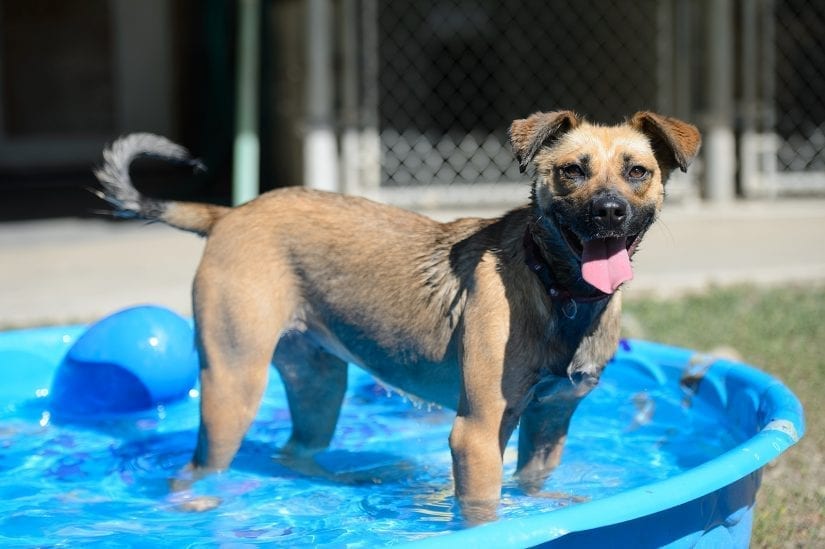With temperatures rising you might be looking for fun ways to cool off with your furry friend. Swimming is a great summer activity to enjoy with your dog: it’s low-impact, it’s enjoyable, and it’s a fantastic way to beat the heat. However, like most physical activities, there are a number of safety issues to keep in mind.

Here are seven tips to swim safely with your dog this summer. By making safety a top priority for your pet, you’re ensuring your pet’s day of fun at the water starts off swimmingly.
1. Don’t assume all dogs can swim
Some dogs naturally gravitate towards water, while others steer clear. Even though a dog may instinctively attempt to dog paddle if they find themselves in water, they do have to be taught how to safely swim. Teaching a dog to swim includes gradual introductions to water at a pace the dog is comfortable with and most importantly, how to get out of water. This is especially important for swimming in pools with dogs; your dog must learn where the stairs are as they usually can’t climb up and out of the sides.
Some dogs might respond well to swimming while others might not. If your dog isn’t a water baby, don’t sweat it. Find another fun activity that both of you can enjoy together.
2. Have your dog wear a life jacket whenever in deep or unpredictable waters
Your dog might be a good strong swimmer, but that doesn’t mean they will always want to swim nor does it mean they will always be swimming at their best. Even the most experienced swimmers will get overwhelmed by strong current or waves. Unfortunately, water accidents can happen at any time — whether you’re at the lake, the beach, or in the family pool. In order to avoid any tragedy it’s best to be as proactive as possible and equip your dog with a comfortable and appropriate life jacket whenever they’re around water. This includes when they’re on a boat!
When fitting your dog for a life jacket, it’s a good idea to take their measurements before buying one or take them down to the local pet store to try one on, especially if they have an atypical build.
3. Ensure your dog responds well to cues
Basic manners and recall are essential when it comes to swimming safely with your dog. Your dog needs to respond well to your cues when in the water, just like when on land. Having a good recall and responding to your cues is a safe way for your pet to avoid any potential danger or threat while in the water.
If your dog needs to brush up on their basic skills, manners or recall, an AnimalKind accredited trainer can help you.
4. Check to see if the water is safe
Most dogs have a tendency to jump into the water without hesitation but it’s a good idea to teach your dog to wait before he leaps. This way you’re able to check for signs of anything that could be harmful to your pup, including: riptides or undertows; dangerous objects, like submerged tree trunks or boulders; dangerous animals, like snakes or jellyfish; or other people in the water, like boaters, fishermen, or young children.

5. Be cautious when it comes to your dog drinking from outdoor water sources
Drinking from outdoor sources of water can be harmful for your pooch. Generally speaking it is safe to let dogs drink out of flowing water and streams, but not stagnant puddles or pools of water, which can be contaminated with various microscopic organisms that can make your dog sick.
Salt water is also toxic for your dog when ingested. For some dogs, a few mouthfuls of ocean water might give them diarrhea. Consuming large amounts of salt water can even be fatal.
This is why you should bring along fresh water for your dog to keep hydrated whether you’re out at the beach, on the boat, or on a hike. If you can’t carry enough water for both of you then consider bringing a water filtration device to filter the water that you’ll come across. If you notice your dog drinking from the ocean or a lake, call them over to you and reward them for leaving the water with a treat and give them a clean water source to drink from instead. If you notice that your dog seems sick after drinking from an unknown water source, call your veterinarian to schedule a check-up.
6. Rinse off your dog after swimming
It’s a good habit to rinse off, or even bathe, your dog after swimming in order to help rid them of any bacteria that might have collected on their fur from the water. Bathing will also clean off any chemicals as well as alleviate any itchiness caused by chlorine, sand or any other debris. You should also check your dog’s ears post-swim ensuring they’re clean and dried, as dogs who swim a lot are prone to ear infections. If your dog has an active ear infection or gets them regularly, it is recommended to avoid swimming or any activities that could add moisture to the ear canal.
7. Learn first aid training
Whether you’re on land or sea, one of the best things you can do for your pet’s safety is to learn first aid training. Consult local organizations like the Red Cross for classes and workshops.
